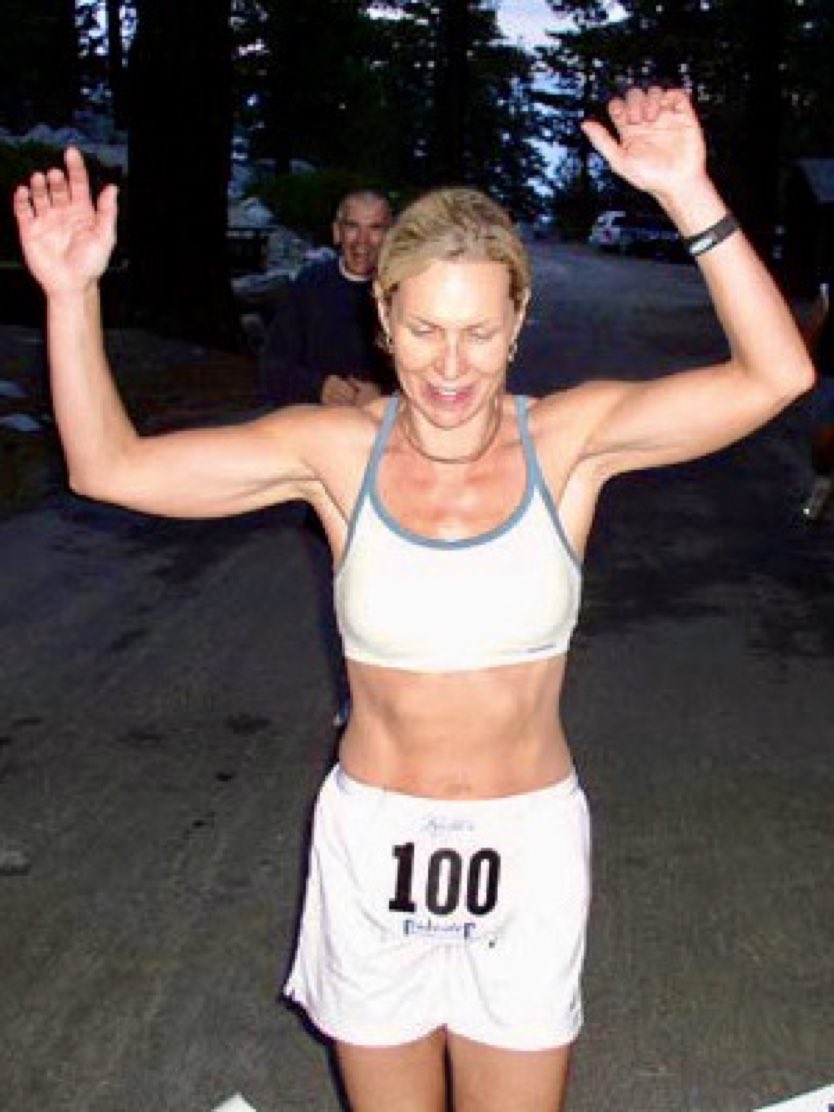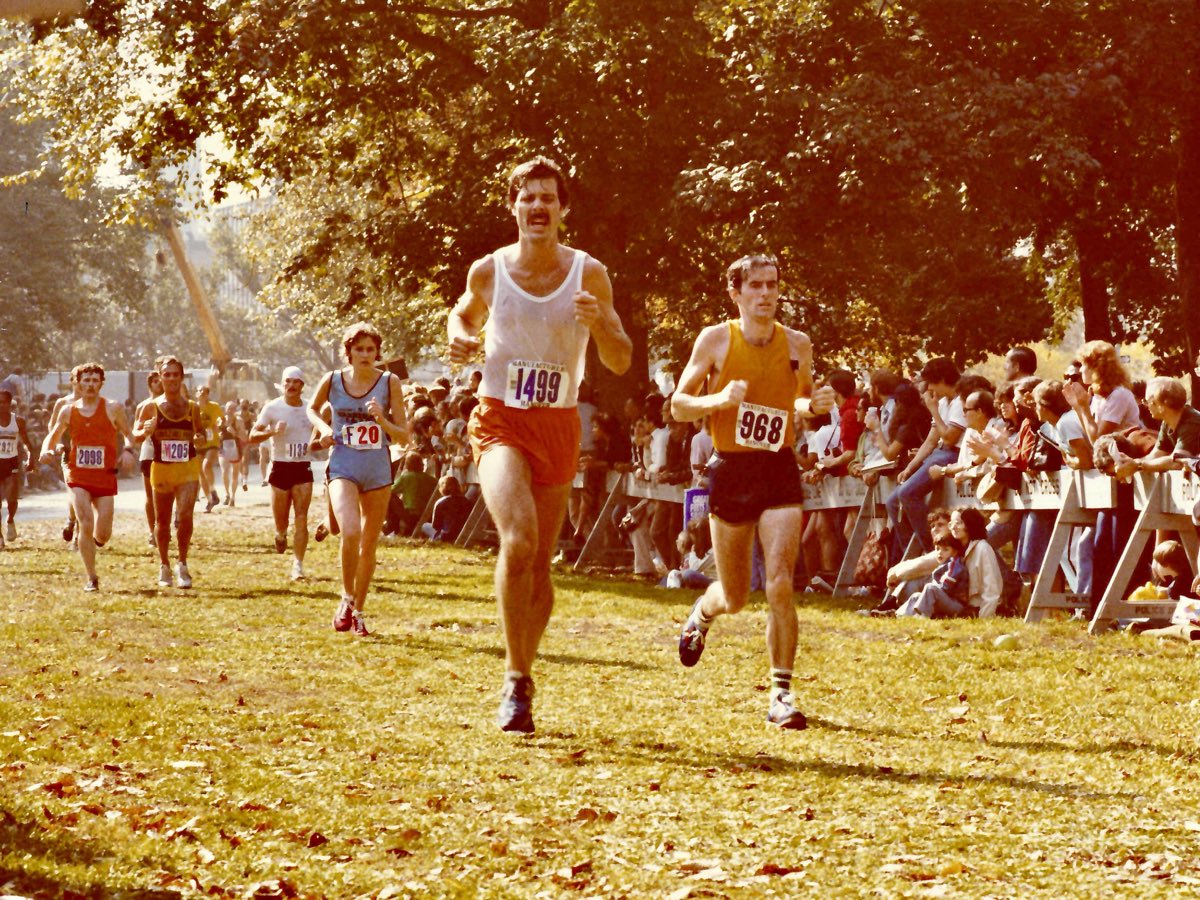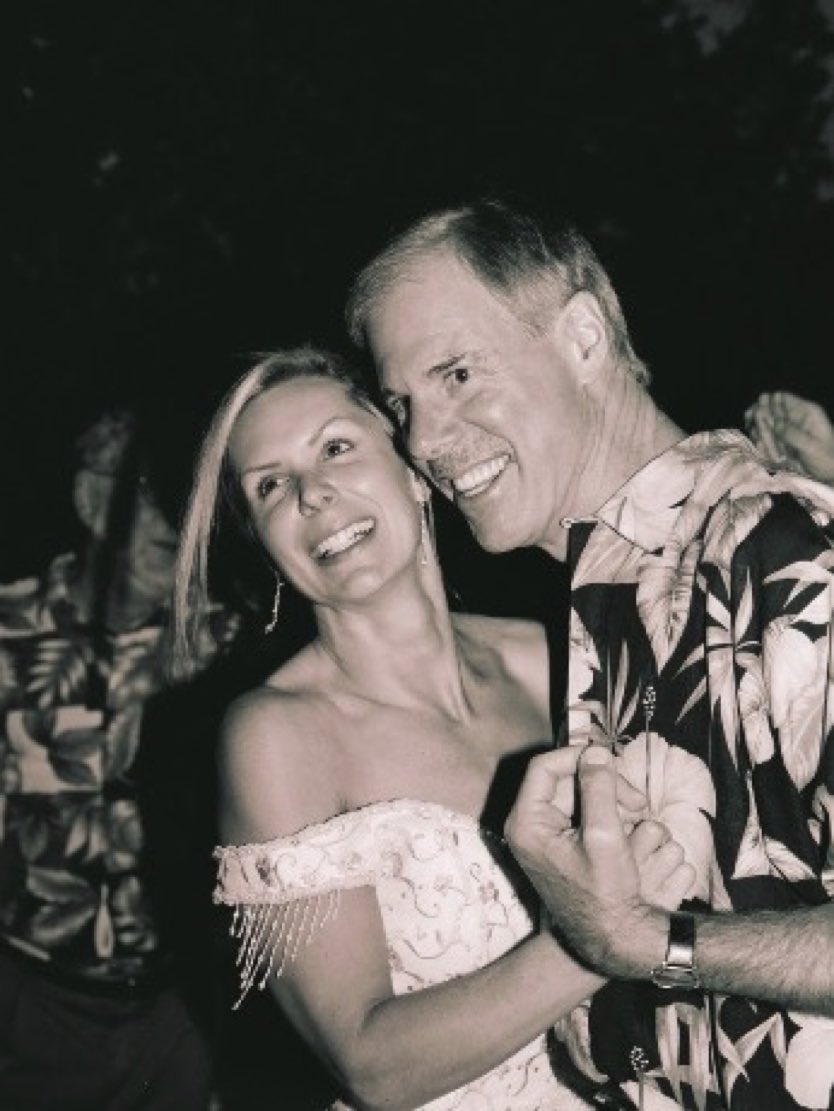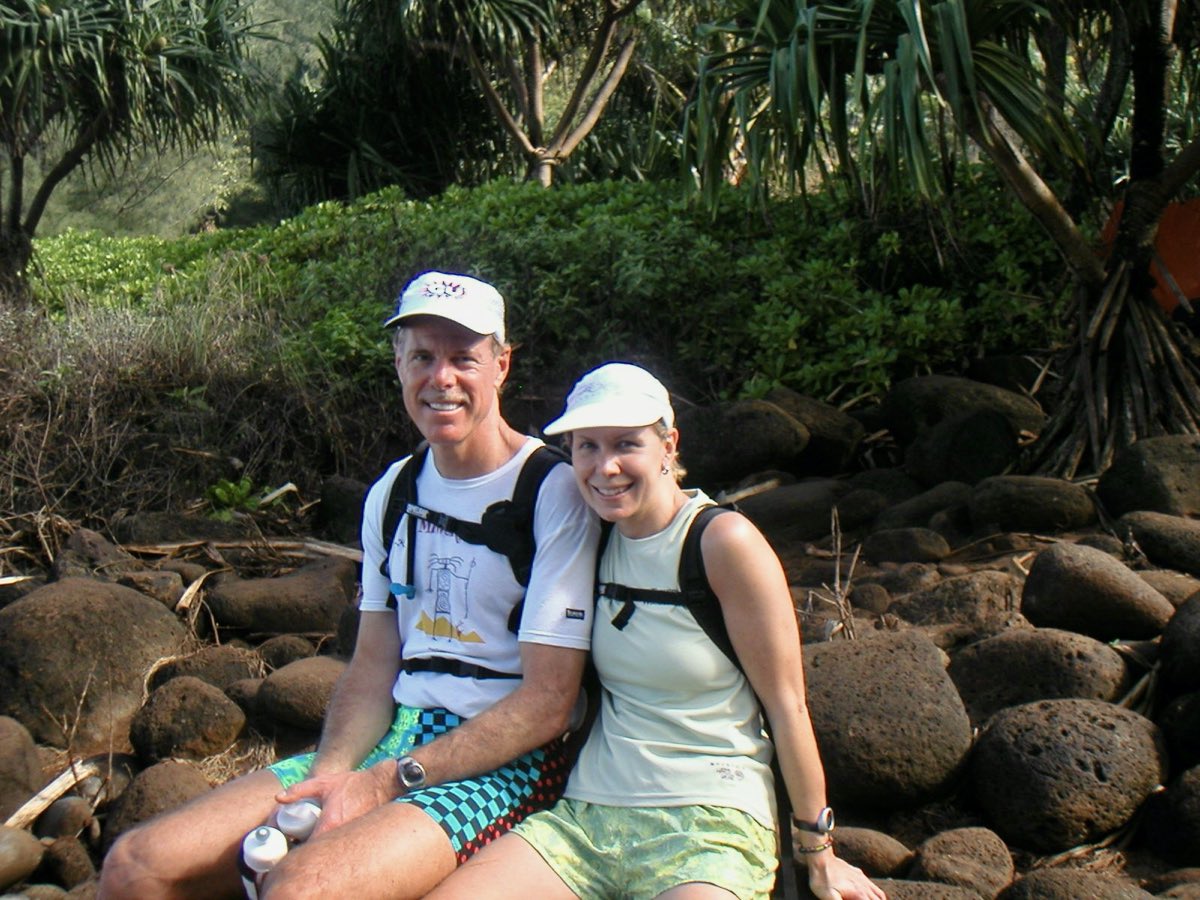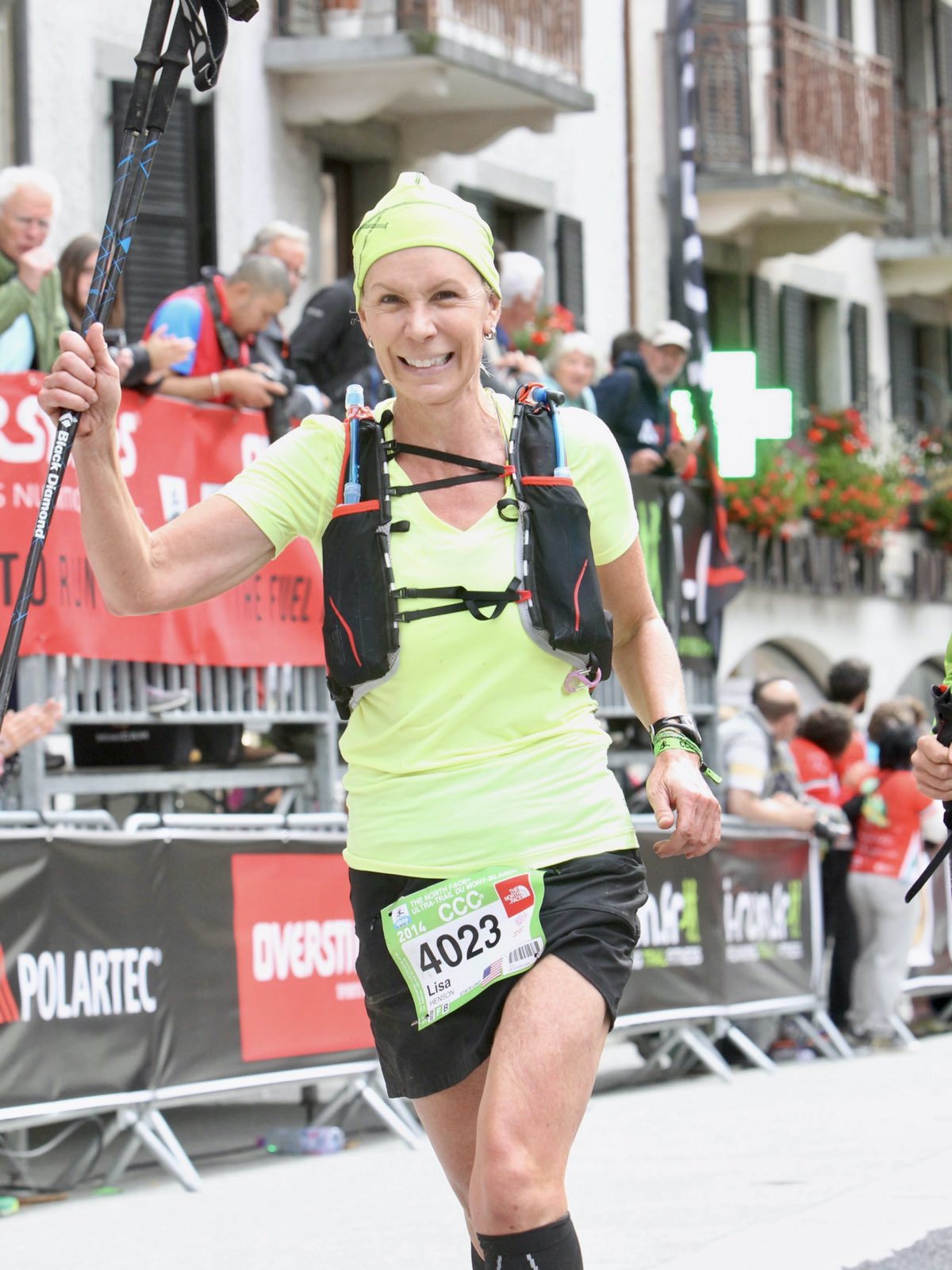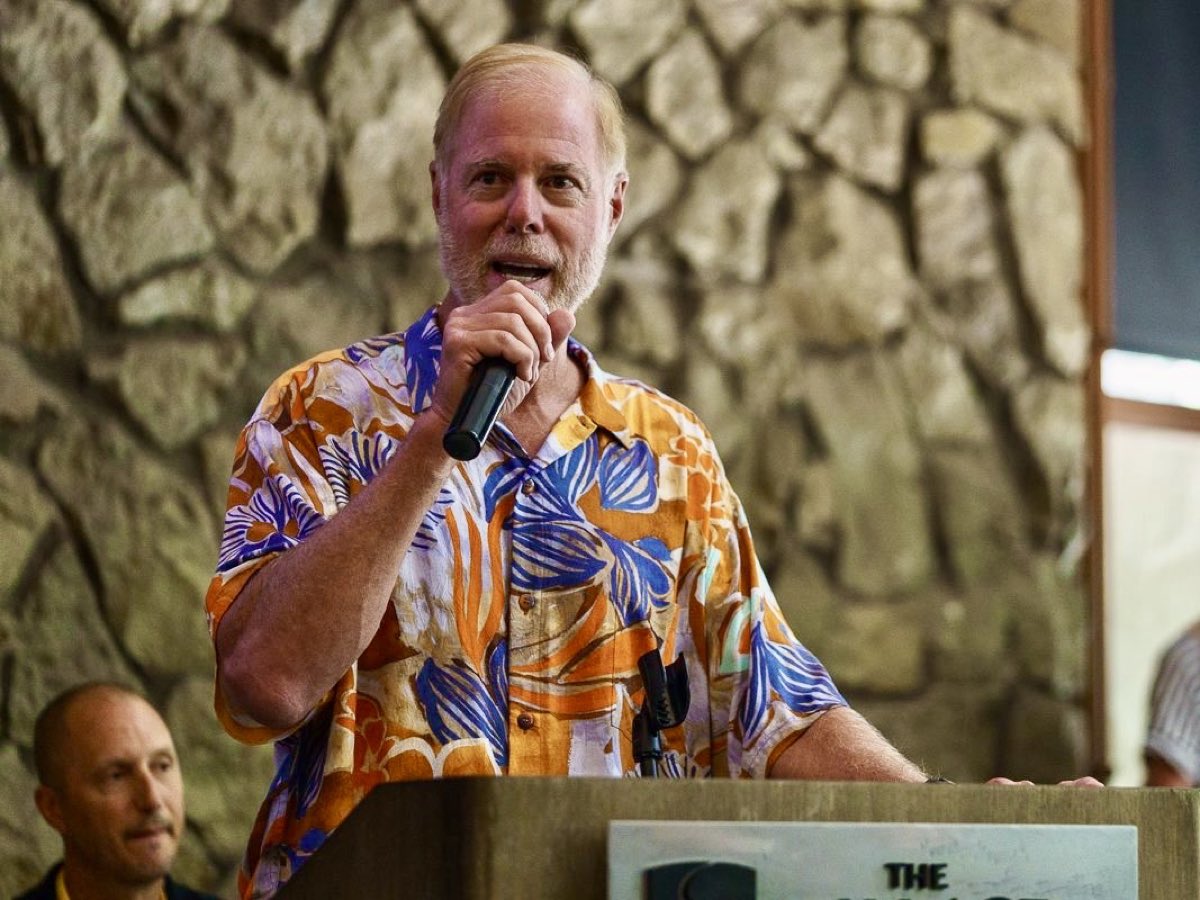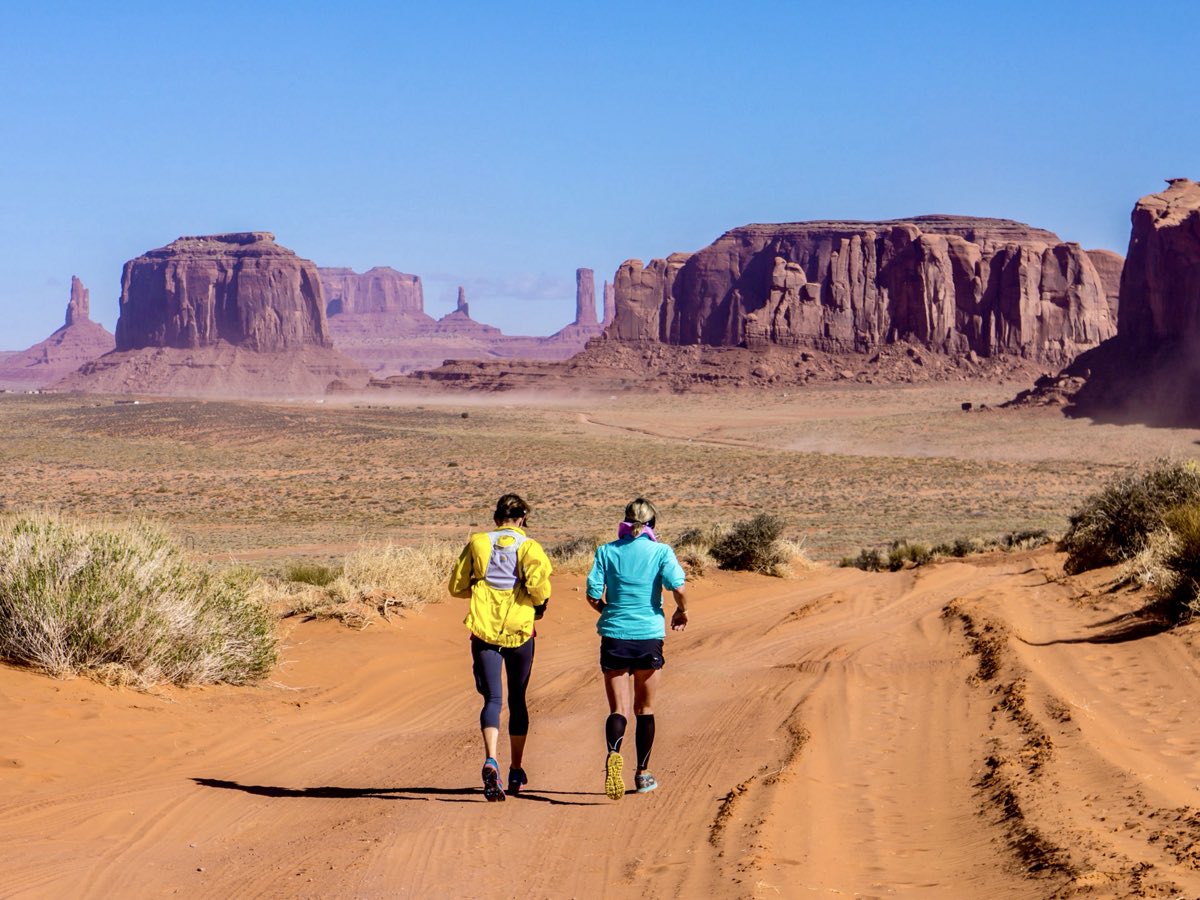Over the past 40 years, there is perhaps no other couple that has made the impact and influence on the American ultrarunning community as Lisa Henson and John Medinger. They each dove passionately into this sport, found each other, and have uplifted innumerous others along the way. They’ve created a handful of the sport’s most iconic events; served as race directors, volunteers, and pacers; published the sport’s premier print publication; and continuously sought and shared the joy of running.
“I am sure there are others in the ultrarunning community who have contributed as much time and effort running and volunteering at ultramarathons, but I doubt you will find another couple who have had the broad impact that T.J. and Lisa have had,” says John Catts, who took over as race director of the Quad Dipsea, after John Medinger retired the torch. Catts first met John Medinger—a.k.a. T.J. or Tropical John, an ode to the colorful Hawaiian shirts that he wears on all occasions, even his wedding day—at Quad Dipsea, in 1998.
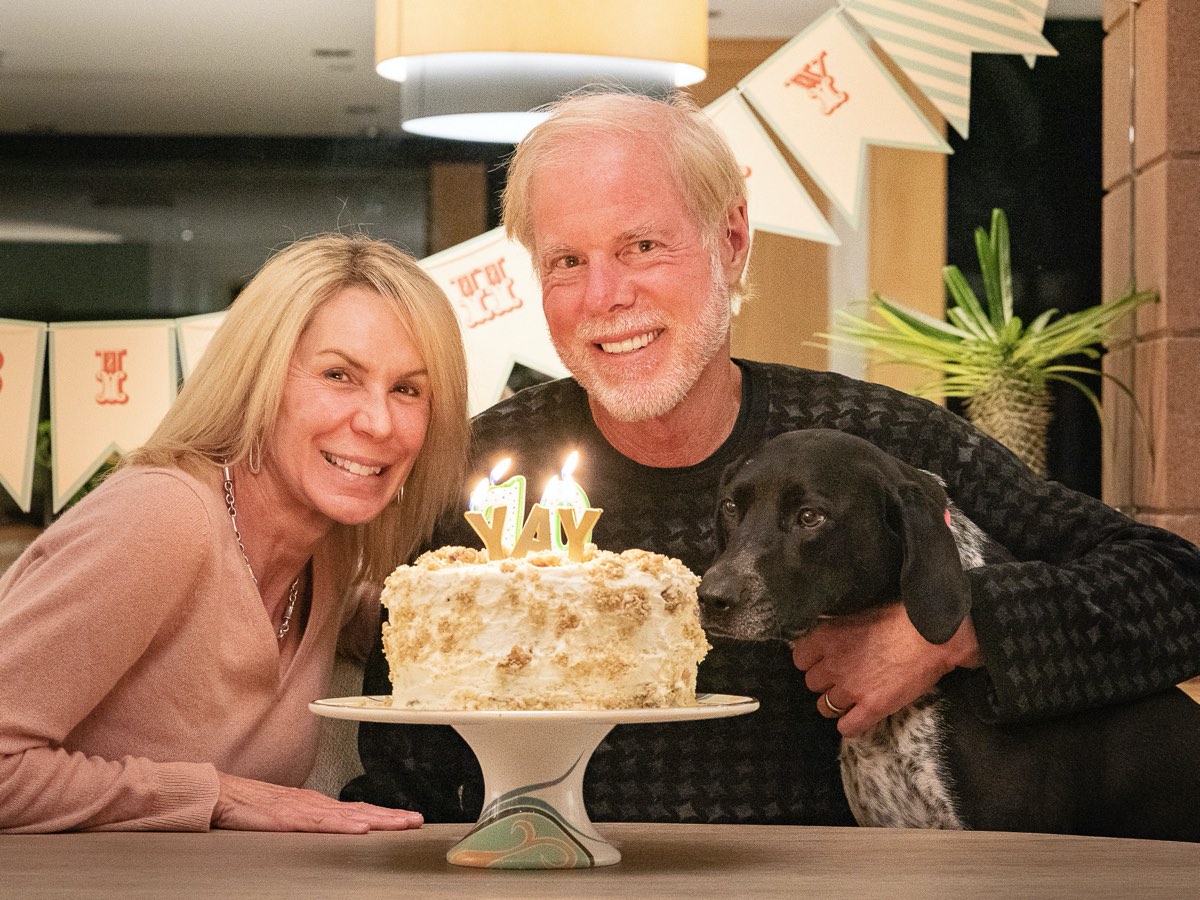
Lisa Henson, Tropical John Medinger, and Zephyr. In this photo, taken in January of 2021, John is celebrating his 70th birthday. Photo: Gary Wang
A few years later, John met Lisa, albeit briefly, at a friend’s ultrarunning party, two nights before the 2001 Western States 100. They both lived in Oakland, California, but on different sides of town. And despite having several mutual friends, they’d never crossed paths on the trails, because Lisa’s work schedule as a stock trader kept her routine on the U.S. Eastern Time schedule. She worked Monday through Friday at 5:30 a.m. and then hit the trails in the afternoons.
“When the list of runners came out after the race lottery, I saw Lisa’s name and said to Rocket [Editor’s Note: Errol Jones], ‘How could there be a woman running the Western States 100, who lives here, and we don’t know her?’ It was funny that someone could get as far as qualifying for the Western States 100 and we didn’t know them. We thought we knew everyone,” says John.
Indeed, Lisa was a passionate runner. She first got into the sport at 34 years old, when she co-owned a bar in downtown San Francisco, which she steered for eight years. One of her customers was training for a marathon and she thought, That sounds like fun. In 1992, she finished her first 26-mile race. She enjoyed it so much that she ran more than 40 marathons over the next five years. In 1997, one of her roommates signed up for a trail race, which “sounded like the next great thing,” so she registered for the Run on the Sly 50k. “After doing my first trail race, I was completely hooked,” she says.
Four years later, following her 2001 Western States 100 debut, Lisa joined the Oakland group runs every Tuesday night that John helped organize. The next summer, Lisa returned to race the 2002 edition—and had a crush curveball mid-race. “On race day, John was at every single aid station—every time I arrived, he was there. I was like, ‘Is the President of [the Board of Directors of the] Western States 100 hanging out with my sister? How weird is that?’ I thought he was into my sister,” says Lisa.
John adds, “Lisa’s sister isn’t a runner—the crew had no idea what they were doing. Then, Lisa was pretty nauseous for the last bit of the race and after she finished. So, at the awards ceremony—which is held a couple of hours after the race finishes—it was hot out, and she was so sick. She was laying in the shade on a picnic table and couldn’t make it inside. I was pretty sure I’d see her the following Tuesday at the group run, so I grabbed her buckle and hand delivered it.” The week after giving her the buckle, John called to ask her out to lunch. The rest is history.
By that time, Lisa had long left the restaurant business. She had a degree in interior design but it had been a decade since she graduated. “I was seriously unemployable when we decided to sell the bar, in the early 1990s. All of my customers were people from the stock exchange and financial services, so I worked my way up at Bank of America, moved to the trading desk, and was at a venture-capital firm when John and I met,” says Lisa.
John had a degree in chemical engineering and a Master of Business Administration but that didn’t hold for him. “I switched out of engineering and into general-management stuff pretty early in my career. I worked with joint ventures, mergers and acquisitions, and eventually helped create a small investment-banking group within a big company to invest their money. It was arcane, highly profitable, and I did it for 16 years,” says John, who’d started running in 1974, after he graduated college, when he lived in Mill Valley.
A friend of his was a serious mountain climber and would run a few miles on his lunch break, to train for an expedition. He “conned” John into joining him. The only running John had previously done was wind sprints to get in shape for playing in a full-court basketball league. After two years of lunchtime jogs, John trained for his first marathon. He got involved with a San Francisco running group, the Pamakid Runners Club, which launched the San Francisco Marathon in 1977. “I liked the idea of giving something back and found the process of putting on an event interesting. I was a volunteer and then became President of the club,” says John.
On January 6, 1980, John ran a 29-mile run for his 29th birthday—a rendezvous with friends that evolved into the famed 50k fat-ass event, the Epiphany Ultra. This birthday bash doubled as his first-ever ultra. The following year, he ran the 50-mile Challenge Cup in San Francisco’s Golden Gate Park. “That was my first–and fastest–50 miler. The Western States 100 had started, but I was unaware of it. Most ultras in that time period were road races and had a different vibe to them. The only reason you’d run 50 miles on a road was to see how fast you could do it—that was a thing. Then, I ran the original Dipsea Race a couple of times, because I lived in town where it started. I was a 2:50 marathoner, but I was horrible on trails. This was a rough trail with stairs, rocks, and roots, and I was trying not to hurt myself,” says John, who then completed his first trail ultra: the 1982 Skyline 50k, the oldest 50k in the country. Around that time, John connected to a small group of experienced local trail runners including Dick Collins, Carol LaPlant, Ruth Anderson, and Orin Dahl.
“I was a newbie and there were hardly any trail races back then. There was the Western States 100 and a few others—the American River 50 Mile, Nugget 50 Mile, and Skyline 50k. Everyone in this group lived scattered around the San Francisco Bay Area, and every couple of months we got together on a Saturday and someone hosted a run,” says John. “I was a road guy and the only trail I really knew was the Dipsea Trail, so I said,’We’ll do it four times as a fun run.’” That was 1983. Two years later, their dozen-runner group “invited the world” and 80 runners showed up to the event, known as the Quad Dipsea, featuring 9,200 feet of ascent in 28 miles.
Also in 1983, John paced a friend at the Western States 100 and hasn’t missed a race since. “In 1983, the race had gone on for five years and no one knew anything about anything. Yet, they were running 100 miles. They knew nothing about gear or nutrition and half the things we have now didn’t exist. My friend dropped around mile 40, so we drove down to the American River crossing [at mile 78]—which you haven’t been able to do for 20 years during the race—and saw the second guy in the lead. As it got dark, we could see runners coming down the hill with flashlights, because headlamps hadn’t been invented, yet. Only a few people were at the aid station. We gave them a hand and didn’t end up leaving until 5 a.m. the next morning when the aid station closed. I was in awe of these people—these were the real pioneers. I’ve been back every year since. I can’t imagine not being there. We’ve been announcing at finish line for the last 11 years, so that’s a lot of fun, too: 17 hours of announcing,” says John. By 1991, he’d joined the nonprofit event’s Board of Directors, where he’s served for the past 30 years, advising and orchestrating the world-famous 100 miler including two four-year terms as President. In 1999, John grabbed the race-director reins for the Miwok 100k, too.
After Lisa and John married, in 2003, they knew they had to get out of the “rat race” of their investment jobs. “We were working hard, Lisa had weird work hours, and the work didn’t really define us—it was a means to an end. Our love and passion was nature, travel, running, and trails. Work paid the bills. We met with our financial advisor and figured out that if we didn’t spend any more money than we currently were spending, we’d saved enough and didn’t need to work anymore,” says John. So they moved to Healdsburg, a small town with great trails in California’s Wine Country, an area north of San Francisco that’s known for its wineries and cuisine. Lisa retired. John stayed on to work remotely for a year until they found a replacement.
As a post-retirement project, then 55-year-old John and 45-year-old Lisa bought UltraRunning Magazine, in 2007, from former publisher Don Allison, who was handling the entire publication solo. “I was like, ‘Don is doing it all by himself and there are four of us–so how hard could it be?’ When we bought the magazine, we had two moths to get an issue out, and we were severely mistaken that it would be easy. We didn’t know anything,” says Lisa. Among their small four-person crew, they hired friend Tia Bodington as editor. Lisa adds, “I did the advertising, subscriptions, customer service, and whatever didn’t fall under others’ titles, it fell to me. I had two months to find an ad. I was like, ‘I guess you call people to ask them?’”
But, they did have a network in the running industry. So, they called Brooks Running and asked them for a favor, to place an ad, so that other brands would be influenced to do the same. “It’s a good thing there was Google, because as I’d make calls about ads, I’d need to look up all these acronyms—there was this entire lingo,” says Lisa. As publisher, John kept the books, paid the bills, worked with the bank, and helped with customer service, too.
The duo paid a salary to the small group they’d hired but didn’t take one themselves. It was like race directing, says John. They just wanted to break even. “It was a small business, but it was halfway a hobby, and our goal was to make the magazine better and sport better. Sometimes we got paid a bit and sometimes we didn’t. It was great for reducing taxes and expensing trips,” says John. Throughout the year, they’d travel across the country for race events and would host pizza parties for magazine subscribers. “We made hundreds of good friends—it was part promotional and part fun,” says Lisa. “It was something to keep us occupied on a subject we were both passionate about and we made a lot of friendships,” says John.
A year after diving into the magazine world, they launched another race, 12 miles northwest of their home, around Lake Sonoma. “Greg Carter and I borrowed a Jones Counter and wheeled it on every trail around Lake Sonoma to measure the distance. We found what could be an out-and-back 50 miler,” says John. “But the last 13 miles of the route, there’s no access to the trail. It’s a marvelously difficult course with more than 10,ooo feet of climbing. You can’t ask people to go 13 miles at the end of a 50 miler without an aid station,” says John. The solution? Bring the aid station in by boat. And it was in this way that the Lake Sonoma 50 Mile was born.
Gary Wang, who has spent countless hours with them helping, crewing, and volunteering at the Miwok 100k, Lake Sonoma 50 Mile, Hardrock 100, and Western States 100, explains, “For the Lake Sonoma 50 Mile, John and Lisa invited top runners, comped their entry fees, and provided host families for their lodging. This led the Lake Sonoma 50 Mile to be one of the most competitive races on the calendar. Bringing top athletes to race together is excellent for our sport. Race-entry fees are not cheap. Their generosity helped develop many talented runners and offered opportunities for them to shine and grow. Jim Walmsley is a perfect example. Ultrarunning is a sport about giving back. One’s achievements are built upon others’ support.” He continues, “Both John and Lisa are incredibly generous in giving back to the community. It is who they are. Their legacy can be traced through the popularity of Quad Dipsea, Miwok, and Lake Sonoma. They both love to help, crew, and pace others at races. Their generosity and organizational skills naturally made them excellent race directors.”
Side by side, John and Lisa’s favorite part of organizing races is the finish line. “We want to be there for each person to high-five or hug whoever is finishing. We take that real seriously,” says Lisa. The other best part, John says, is “being an enabler: running an ultra for the average runner is hugely amazing. There are talented runners but those are the exceptions. Most people only run one or two a year, and it’s a big deal. That’s a big part of our lives and to propagate that into other people’s lives is rewarding for us.”
As an ultrarunning power couple, they’ve managed to send that ripple effect across the country and around the world.
“Although T.J. may have most of these titles, make no mistake, Lisa is an equal partner in most of these activities,” says Catts, who got to know both John and Lisa through participating in and working together at various California ultras like the Way to Cool 50k, Epiphany Ultra, Bandit Ultra Trail Run, and Miwok 100k. Catts is well-versed in John’s curriculum vitae: Quad Dipsea race director from 1983 to 2012; on the Western States 100 Board of Directors from 1991 to 2020, with two terms as president; Miwok 100k race director from 1999 to 2003; Lake Sonoma 50 Mile race director from 2008 to 2018; and owner and publisher of UltraRunning Magazine from 2007 to 2013.
Catts says, “What this list doesn’t show are all the related activities that these two take on, like staffing the announcer’s booth at the finish line for the Western States 100 for all but a couple-hour break, or compiling all the data for and managing the UltraRunner of the Year competition for UltraRunning Magazine. And along the way, T.J. and Lisa have made so many friends in our community that they are the the superglue that helps hold us together, all the while being supportive of runners at all levels, and just making the sport both fun and inspiring for all.”
Catts says, “T.J. and Lisa are very easy and fun to be around, whether it be working on races or other activities. Lisa is the nicest person you could ever meet, and as such people want to help her get things done. T.J. is really good at getting the big picture organized and finding the right people to take on tasks, not micromanaging their efforts, but knowing and trusting that the normal glitches that come with any event will get worked out. And they both do this in a manner that inspires people to do a good job.”
Today, John and Lisa are home to Sedona, Arizona, where they moved 1.5 years ago. John retired from the Western States 100 Board a few months ago and joined the race’s new Advisory Council alongside Donn Zea and Tony Rossmann. “We created an Advisory Council of greybeards. We won’t often deal with day-to-day nitty-gritty details, like the Board does, but we’ll be involved with bigger scope, philosophical issues and discussions like about prize money or drug tests. The Board had the same people for a really long time—a dozen of us had been around for 20 to 30 years. Organizations need new ideas and turnover. Change is good,” says John. The trio’s transition helped make space to usher in three new Board leaders: Magda Boulet, Kara Teklinski, and Billy Yang.
The pair remain as in love with running as ever. Says John, “I’ve been an inveterate record keeper pretty much forever. (Okay, since 1976.) As of today, January 5, I’m sitting at 113,220 miles lifetime and 150 ultras. I turn 70 tomorrow (yikes) and have a vague notion that it would be cool to do at least one more ultra in my seventies. But that depends on there actually being some races to run and of course my body cooperating at least one more time.”
He continues, “Lisa didn’t keep a log until we got together. (I convinced her that it would be a good motivational tool. Of course, these days Strava does everything automatically.) So she doesn’t really know how many miles she has done altogether. Probably 50 to 60,000 miles, somewhere in there. She has done 87 ultras–and still has her eye on getting to 100.”
John and Lisa also love filling their year with travel. It’s traditional for them to cheer on racers at the Lake Sonoma 50 Mile, Hardrock 100, and Western States 100. For vacations, they venture to a coastal destination, like Hawaii or the Caribbean, and to Africa for safaris. “On a safari, every day is a huge adventure. You see all kinds of exotic wildlife. I could do it indefinitely. When we leave after 10 to 12 nights in the bush, I’m not ready to be back,” says John. At home, they run with their dog, Zephyr, who they found as a puppy—starving and full of ticks—while marking the Lake Sonoma course, in April of 2014. And every year, Lisa aims to “eek out a 50 miler,” she says, noting her all-time favorite memory was finishing the Monument Valley 50 Mile on the Navajo Nation.
What’s the best way to conclude an article about the pair whose legacy is interwoven in what American ultrarunning is today? Very simply, to not end it. As their story continues at the races, on the crew teams, in the announcer’s booth, and among shared adventures on the trails, so does all of ours.
Call for Comments
Woohoo, let’s share some stories about Lisa Henson and John Medinger! Click into the comments section and leave yours.
